1994 CADILLAC ELDORADO check engine
[x] Cancel search: check enginePage 165 of 398
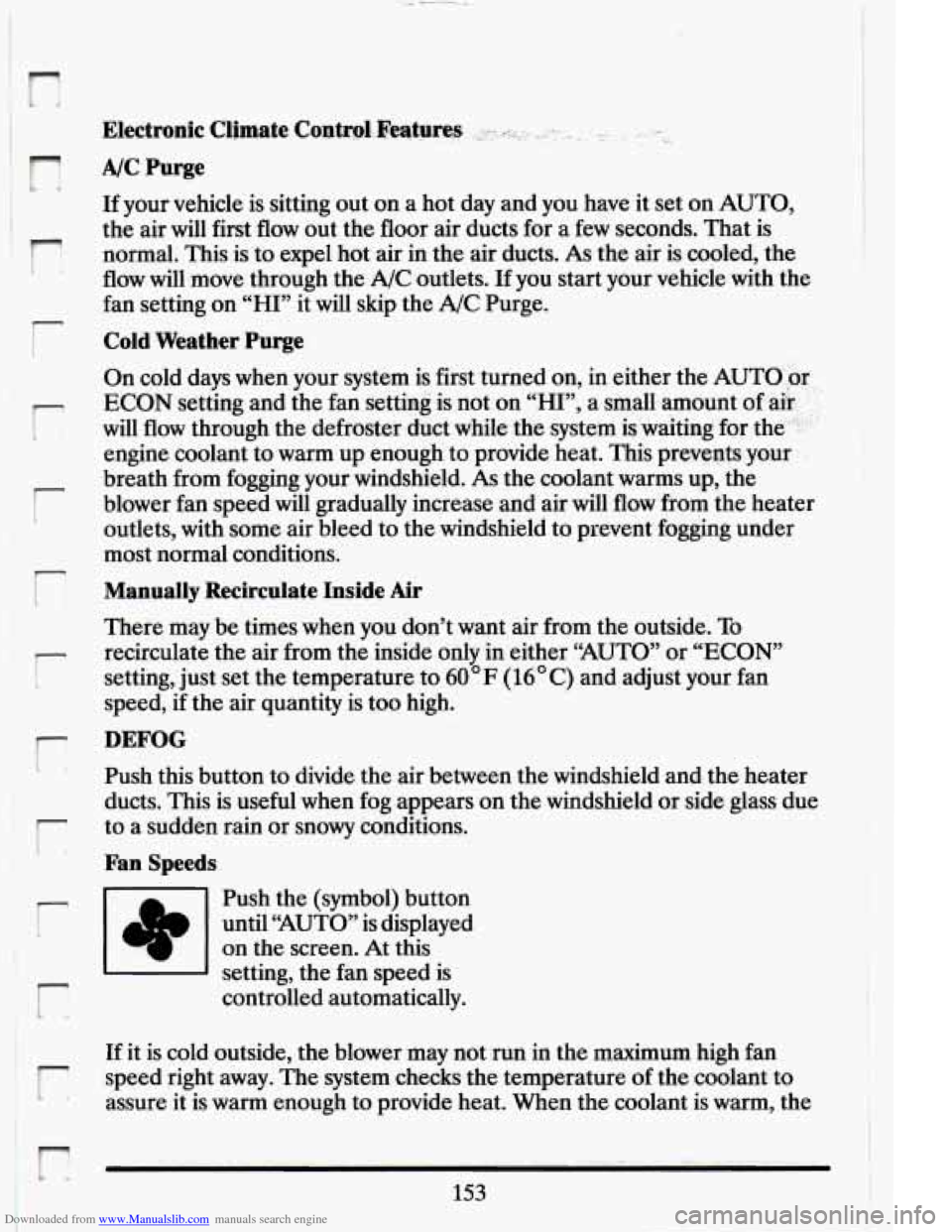
Downloaded from www.Manualslib.com manuals search engine n
ir
’r
I- t
r r
r L
r I 1
A/C Purge
If your vehicle is sitting out on a hot day and you have it set on AUTO,
the air will first flow out the floor air ducts for a few seconds. That is
normal. This is to
expel hot -air in the air ducts. As the air is cooled, the
flow will move through the A/C outlets.
If you start your vehicle with the
fan setting on “HI” it will skip the A/C Purge.
Cold Weather Purge
On cold days when your system is first turnea on, in either the AUTO’br..
ECON setting and the fan setting
is not on “HI”, a small amount of ah ::.
will flow through the defroster duct while- the system is waiting for the
engine coolant to warm up enough to provide heat. This prevents your
breath from fogging your windshield. As the coolant warms up, the
blower fan speed will gradually increase and air will flow from the heater
outlets, with some air bleed to the windshield to prevent fogging under
most normal conditions.
..
Manually Recirculate Inside Air
There may be times when you don’t want air from the outside. To
recirculate the air from the inside only in either “AUTO” or “ECON”
setting, just set the temperature to
60 F (16 C) and adjust your fan
speed, if the air quantity is too high.
DEFOG
Push this button to divide the air between the windshield and the heater
ducts.
This is useful when fog appears on the windshield or side glass due
to a sudden rain or snowy conditions.
Fan Speeds
Push the (symbol) button
until “AUTO” is displayed on the screen. At this
I 1 setting, the fan speed is
controlled automatically.
If it is cold outside, the blower may not run in the maximum high fan
speed right away. The system checksthe temperature
of the coolant to
assure it is warm enough to provide heat. When the coolant is warm, the
153
Page 171 of 398
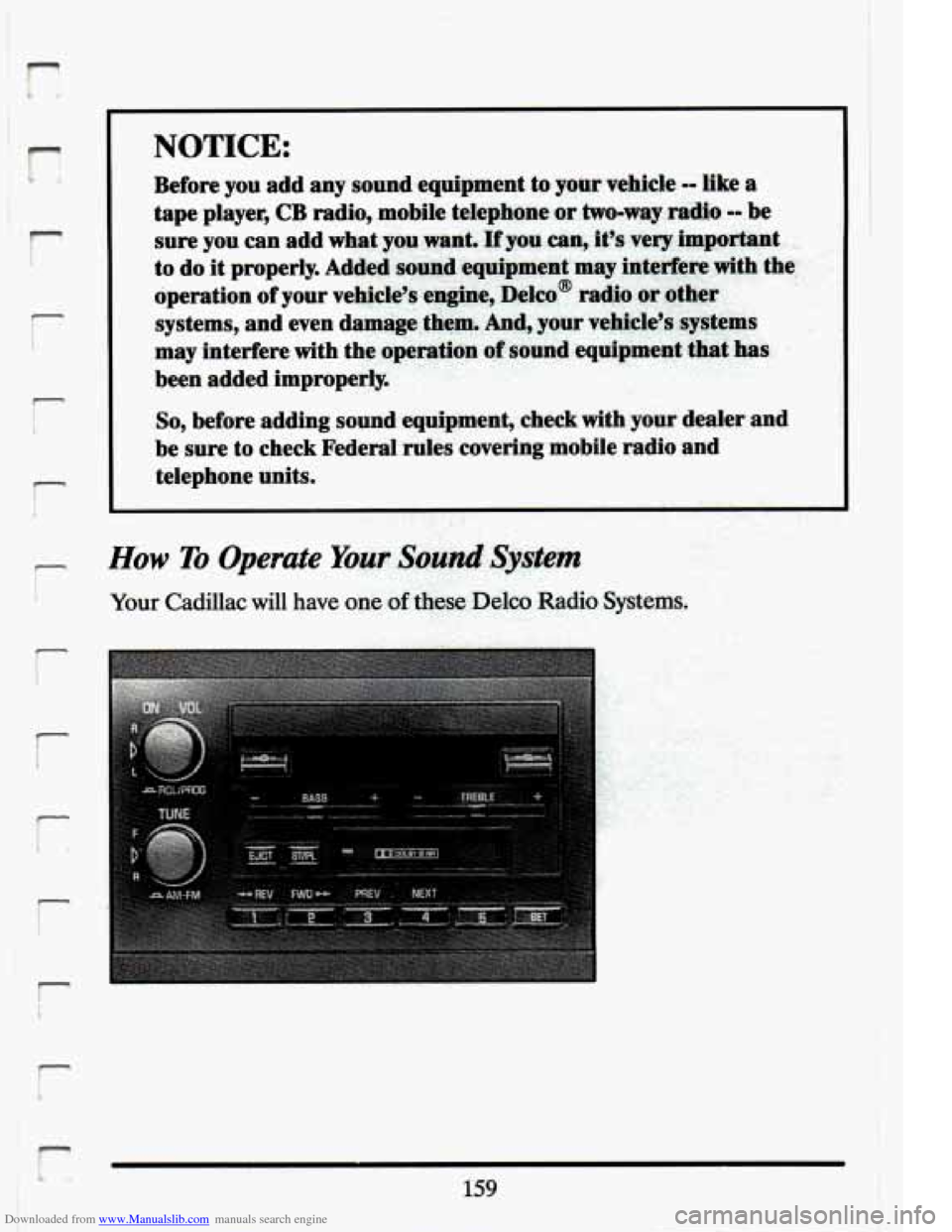
Downloaded from www.Manualslib.com manuals search engine hl
r
i
n
NOTICE:
So, before adding sound equipment, .check with your dealer and
be sure
to check Federal rules covering mobile radio and
telephone units.
r
159
Page 177 of 398
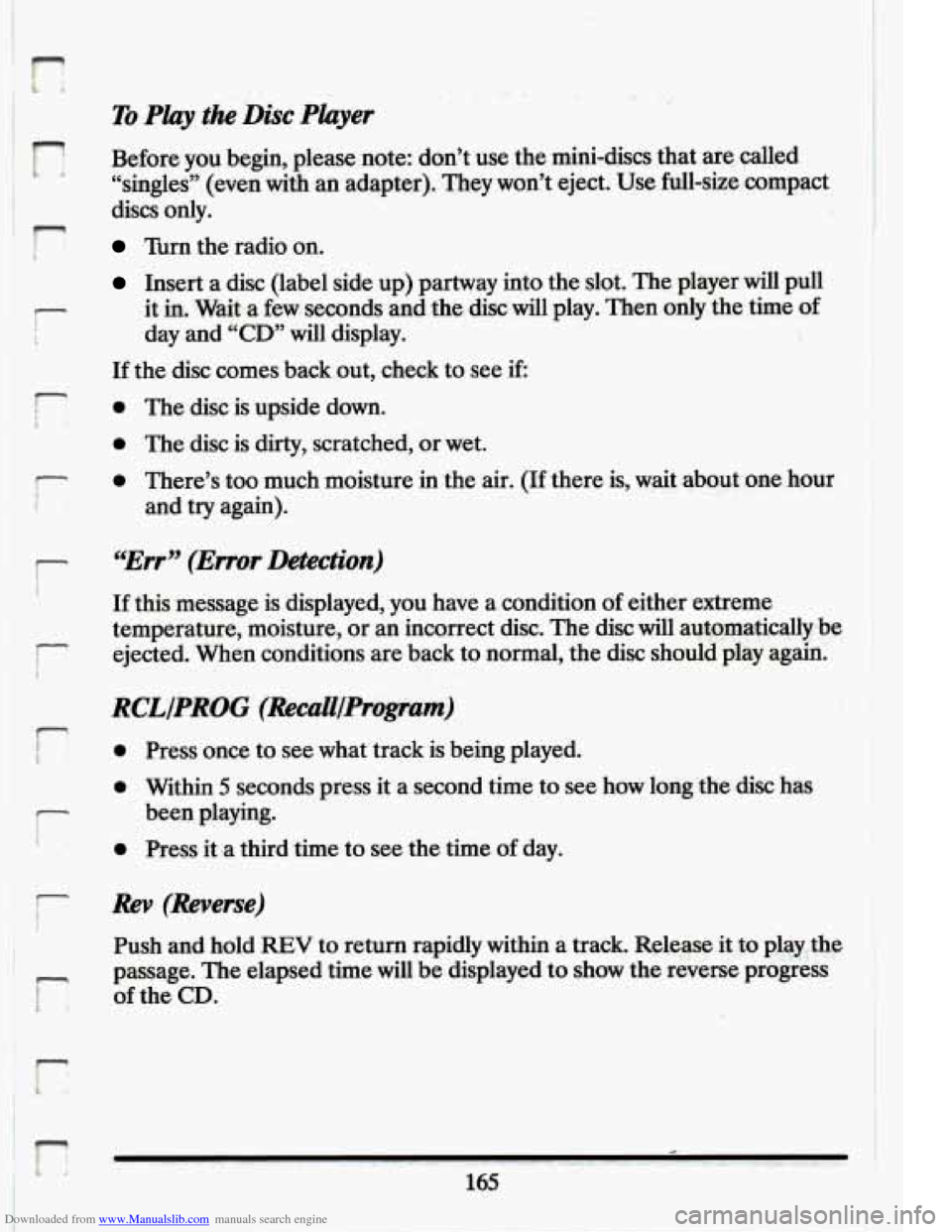
Downloaded from www.Manualslib.com manuals search engine r
r
i
J- i
r
i
F
To Play the Disc Player
..
Before you begin, please note: don’t use the mini-discs that are called
“singles”
(even with an adapter).. They won’t eject. Use full-size compact
discs only.
Turn the radio on.
Insert a disc (label side up) partway into the slot. The player will pull
it in. Wait
a few. seconds and the- d.isc will play. Then only the time of
day and “CD” will display. I
If the disc comes back out, check to see if:
0 The disc is upside down.
0 The disc is dirty, scratched, or wet. :I
0 There’s too much moisture in the air. (If there is, wait about one.hour
I
1
and try again).
66Err” (Error Detection)
If this message is displayed, you have a condition of either extreme
temperature, moisture, or an incorrect disc. The disc will automatically be
ejected. When conditions are back to normal, the disc should play again.
RCLIPROG (&caUIProgram)
0 Press once to see what track is being played.
0 Within 5 seconds press it a second time to see how long the disc has
0 Press it a third time to see the time of day.
been
playing.
... .. , ., .
Rev (Reverse)
Push and hold REV to return rapidly within a track. Release it to play. the
passage. The elapsed time will be displayed to show the reverse progress
of the CD.
h - ........ .. ~ , .. .... ...... __.
165
2.
Page 195 of 398
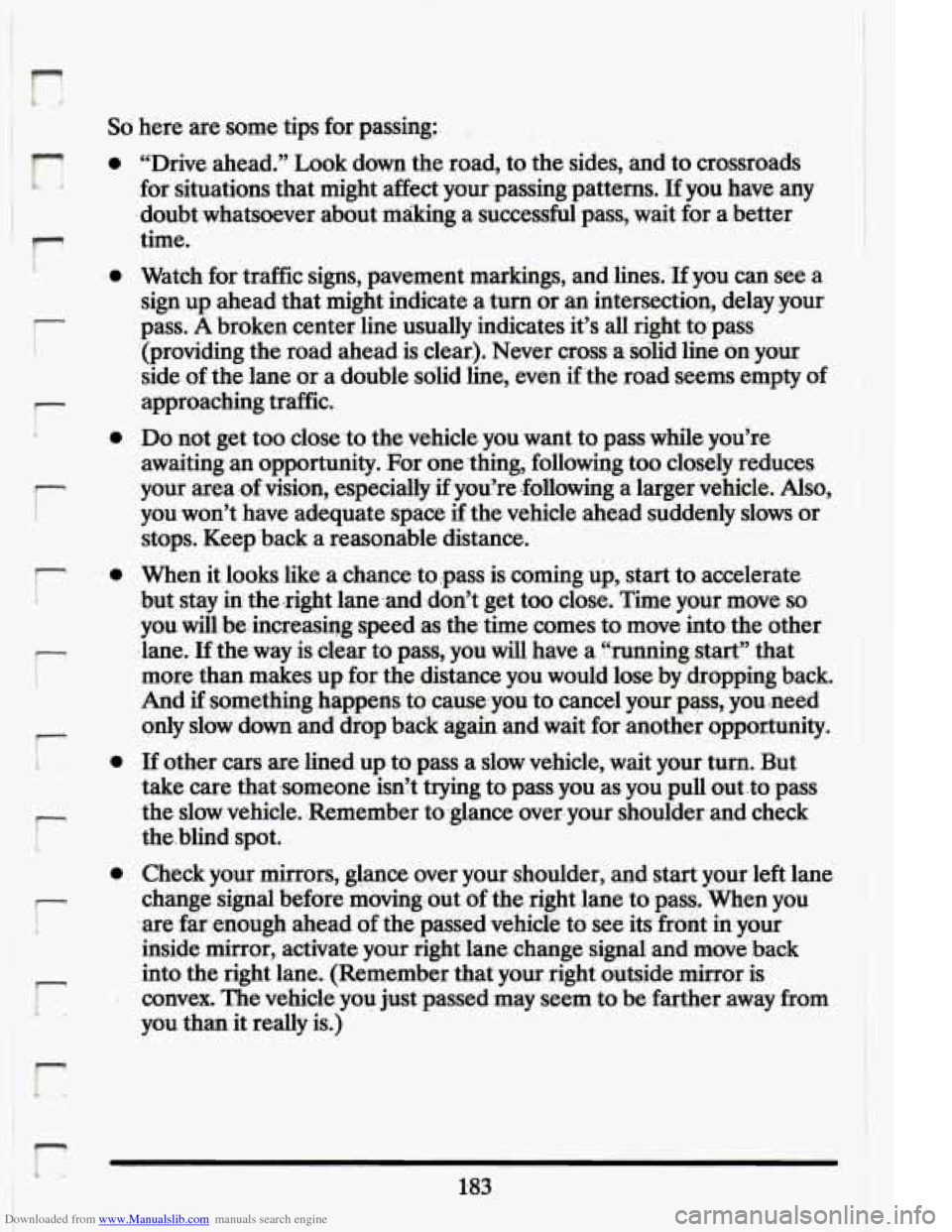
Downloaded from www.Manualslib.com manuals search engine So here are some tips for passing: . .
r I
r
0
0
0
0
r
F
0
F i
0
c
r
“Drive. ahead.” Look down the road, to the sides, and to crossroads
.for situations that might affect your passing patterns.
If you have any
doubt ,whatsoever about making a successful. pass, wait for a.better
time.
.Watch- for traffic signs, pavement markings, and lines.
’If you can see .a
sign up ahead that might indicate a turn or an intersection, delay your
pass.
A broken center line usually .indicates it’s all right to pass
‘(providing the road ahead isclear.):Never cross
a solid line on your
side
of the lane or a double solid line, even if ‘the road. seems empty of
approaching traffic.
Do not :get
too closelo the,vehicle you want.to pass while you’re
awaiting- an opportunity. For .one lthmg, following too closely reduces
your
area ,of vision, especially if you’re .following a ‘larger vehicle. Also,
you-won’t have adequate space if the vehicle ahe:ad suddenly slows or
stops. Keep back a reasonable distance.
When it looks like a .chance: to ,pass
is coming. up, start to. accelerate
.but stay in the.right 1ane.and.don’t.get too dose. Time your move
so
.you wiIl.be .increasing speed as the time comes to move into the other
.lane.
If the way is clear to pass, you will have a .‘‘running, start” that
more than makes up for the distance you would lose
by .dropping back.
And
if something happensto.cause:youto cancel your pass, you need I
only slow down and drop back again and wait for another opportunity.
-If other cars are 1ined.u~ to pass a slow vehicle, wait your turn. But
take care that someone isn’t trying
to pass you as you:,pull outto pass
the slow vehicle. -Remember
to ‘glance over. your shoulder-and check
theblind spot.
Check your mirrors, glance over your shoulder, and start your left lane
change signal before moving.out
of the right .lane to pass,. When you
:are far:enough ahead
of ,the passed vehicle to see its front in. your
inside mirror, activate your right. lane change signal
and move back I
into the right lane. (Remember that your right outside mirror is
convex.
The vehicle you just passed may seem to be farther away from
you than itreally is.)
!,, 1 - ’ - ,- . ..
183
Page 198 of 398
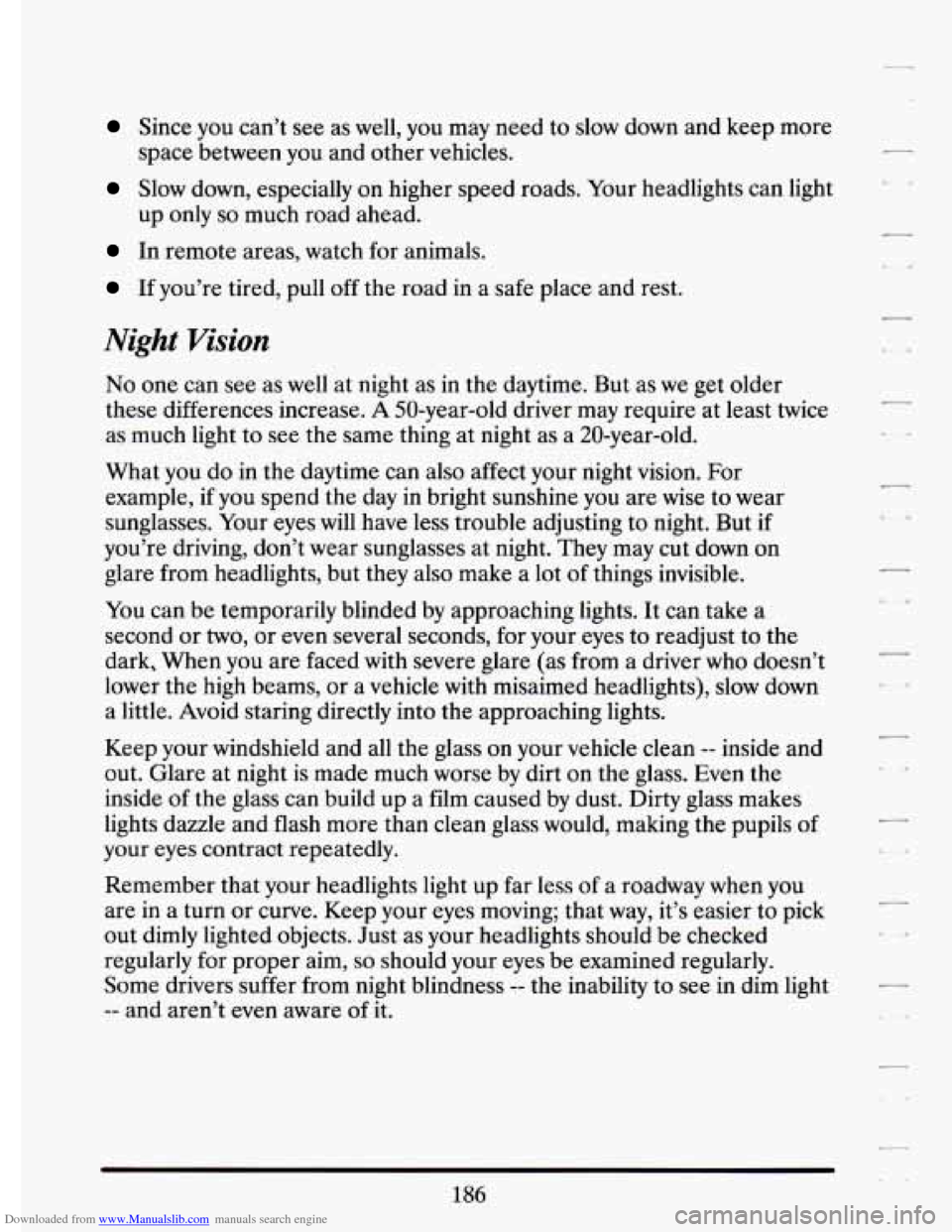
Downloaded from www.Manualslib.com manuals search engine Since you can’t see as well, you may need to slow down and keep more
space between
you and other vehicles.
Slow down, especially on higher speed roads. Your headlights ca\
n light
In remote areas, watch for animals.
If you’re tired, pull off the road in a safe place and rest.
up only
so much road ahead.
Night Vision
No one
can see as well at night as in the daytime. But as we get older
these differences increase.
A 50-year-old driver may require at least twice
as much light to see the same thing at night as a 20-year-old.
What you do in the daytime can also affect your night vision. For
example,
if you spend the day in bright sunshine you are wise to wear
sunglasses. Your eyes
will have less trouble adjusting to night. But if
you’re driving, don’t wear sunglasses at night. They may cut down on
glare from headlights, but they also make
a lot of things invisible.
You can be temporarily blinded by approaching lights. It can take a
second or
two, or even several seconds, for your eyes to readjust to the
dark, When you are faced with severe glare (as from a driver who doesn’t
lower the high beams, or a vehicle
with misaimed headlights), slow down
a little. Avoid staring directly into
the approaching lights.
Keep your windshield and all the glass on your vehicle clean
-- inside and
out. Glare at night is made much worse by dirt on the glass. Even the
inside of the glass can build up a film caused by dust. Dirty glass makes
lights dazzle and flash more than clean glass would, making the pupils of
your eyes contract repeatedly.
Remember that your headlights light up far less
of a roadway when you
are in a turn or curve. Keep your eyes moving; that way, it’s easier to pick
out dimly lighted objects. Just as your headlights should be checked
regularly for proper aim,
so should your eyes be examined regularly.
Some drivers suffer from night blindness
-- the inability to see in dim light
-- and aren’t even aware of it.
-
c -4
186
..
Page 202 of 398
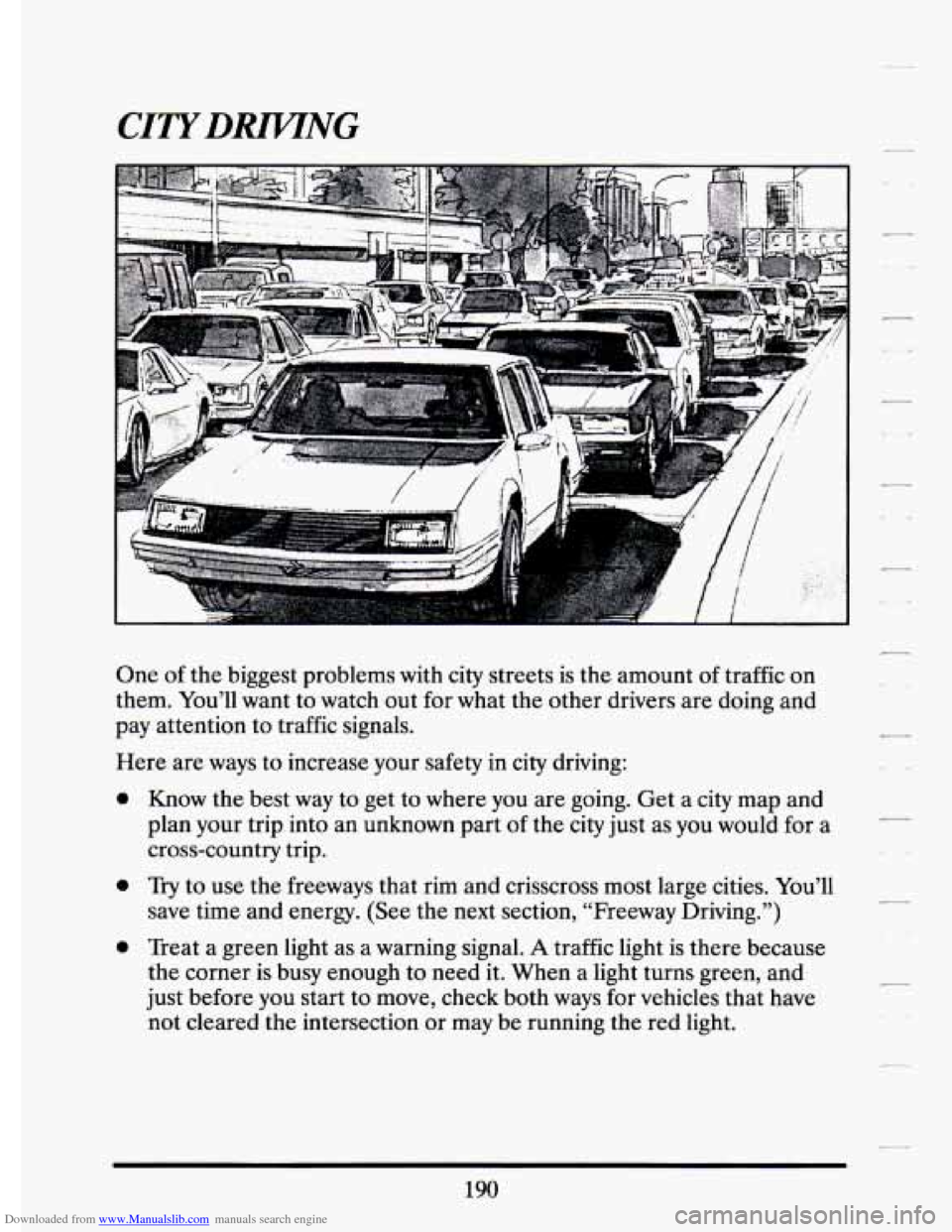
Downloaded from www.Manualslib.com manuals search engine CITYDRZWNG
One of the biggest problems with city streets is the amount of traffic on
them. You’ll want to watch out for what the other drivers are doing and
pay attention to traffic signals.
Here are ways to increase your safety in city driving:
0
0
0
Know the best way to get to where you are going. Get a city map and
plan your trip into an unknown part
of the city just as you would for a
cross-country trip.
Try
to use the freeways that rim and crisscross most large cities. You’ll
save time and energy. (See the next section, “Freeway Driving.”) 7-
Treat a green light as a warning signal. A traffic light is there because
the comer is busy enough to need it. When a light turns green, and
just before you start to move, check both ways
for vehicles that have
not cleared the intersection or may be running the red light.
Page 203 of 398
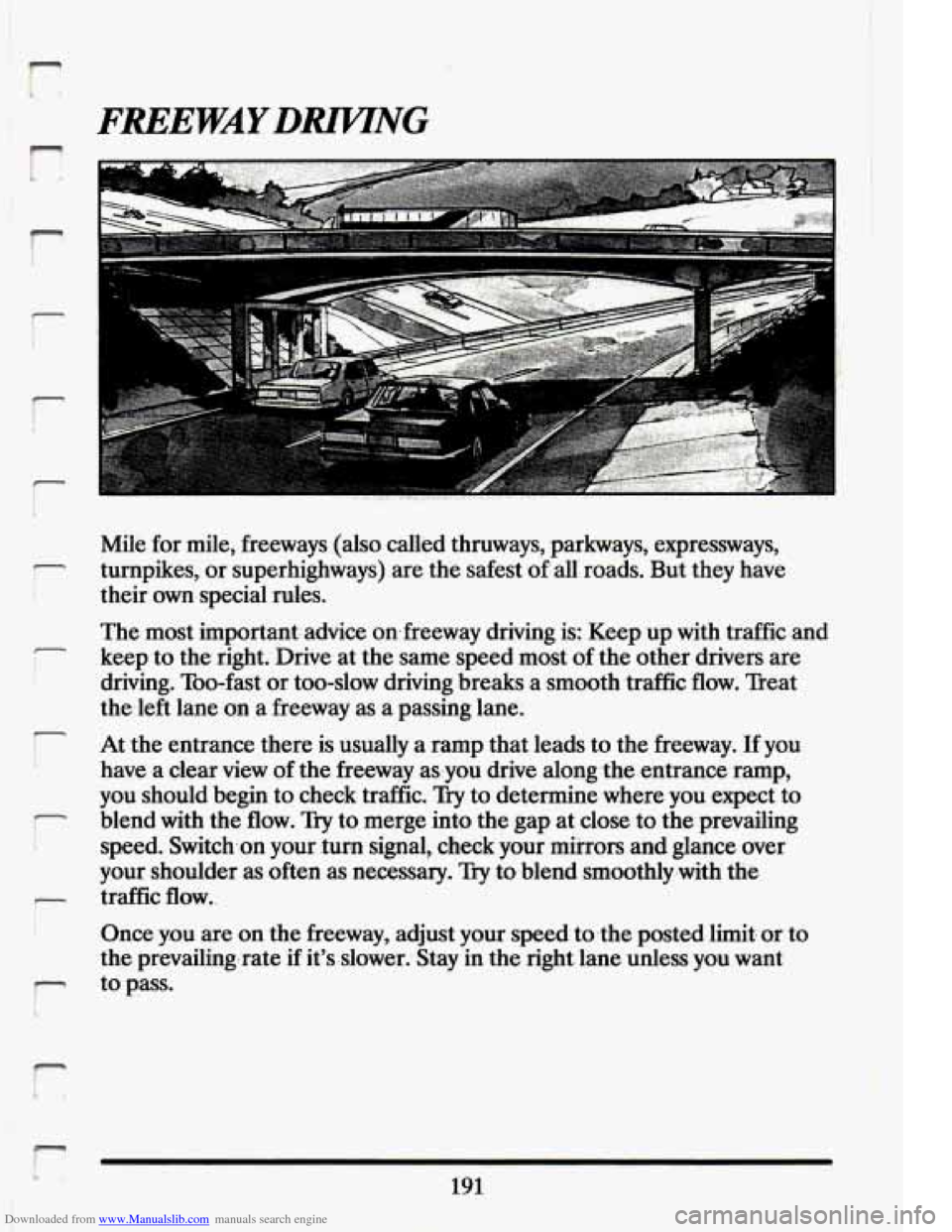
Downloaded from www.Manualslib.com manuals search engine FREEWAYDRZWNG
jr
i'
f
I- E
Mile for mile, freeways (also called thruways, parkways, expressways,
their
own special rules.
The most important: advice on:freeway driving
is: Keep up with traffic-and
keep to the right. Drive at the same speed most of the other drivers are
driving. Too-fast or too-slow driving breaks a smooth.traffic flow. Treat
thedeft lane on a freeway as a passing lane.
r turnpikes, or superhighways) are the safest of all roads. But they have
r
F At the entrance there is usually a ramp that leads to the freeway. If you
have a clear
view of the freeway asyou drive along.the entrance ramp,
you should .begin. to check traffic. Try to determine where you expect to
blend with the flow.
Try to merge into the gap at close to the prevailing
'p speed. Switchan your Purn.signa1, check your mitrors and glance over
your shoulder
as often as necessary. Try toblend smoothly-with the
- traffic flow..
Once you are on the freeway, adjust your speed.to.the posted limit; or to
the prevailing.rate
if it'sslower. Stay in the right. lane unless you want
F to pass.
I
I
I- L 191
Page 204 of 398
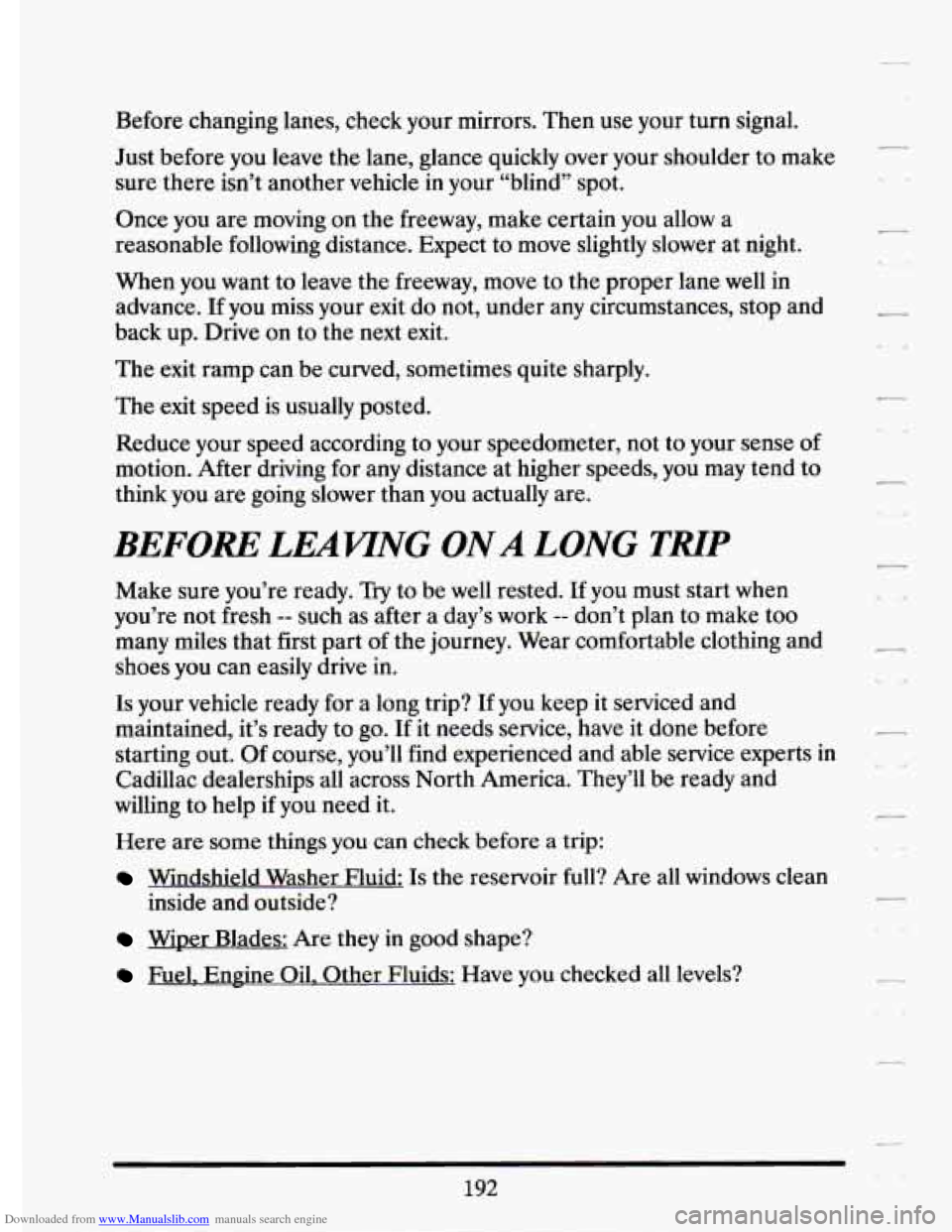
Downloaded from www.Manualslib.com manuals search engine Before changing lanes, check your mirrors. Then use your turn signal.
Just before you leave the lane, glance quickly over your shoulder to make
sure there isn’t another vehicle
in your “blind” spot.
Once you are moving
on the freeway, make certain you allow .a
reasonable following distance. Expect to move slightly slower at night.
When you want to leave the freeway, move to the proper lane well
in
advance. If you miss your exit do not, under any circumstances, stop and
back up. Drive
on to the next exit.
The exit ramp can be-curved, sometimes quite sharply.
The exit speed is usually posted.
Reduce your speed according to your speedometer, not
to your sense of
motion. After driving for any distance at higher speeds, you may tend to
think you are going slower than you actually are.
BEFORE LEAVTNG ONA LONG THP
Make sure you’re ready. Try to be well rested. If you must start when
you’re not fresh
-- such as after a day’s work -- don’t plan to make too
many miles that first part of the journey. Wear comfortable clothing and
shoes you can easily drive in.
Is your vehicle ready for a long trip? If you keep it serviced and
maintained, it’s ready to go. If it needs service, have it done before
-
starting out. Of course, you’ll find experienced and able service experts in
Cadillac dealerships all across North America. They’ll be ready and
willing to help
if you need it.
Here are some things
you can check before a trip:
Windshield Washer Fluid: Is the reservoir full? Are all windows clean
inside and outside?
Wiper Blades: Are they in good,shape?
Fuel, Engine Oil. Other Fluids: Have you checked all levels?
-.
192